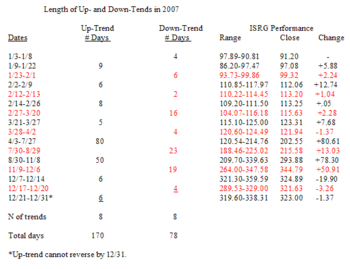The GMI closed out the year at 4+ and the GMI-R at 5+. The GMI indexes focus more on the performance of the tech stocks, as measured by the QQQQ, rather then the other stocks in the major indexes. The GMI therefore is masking the deterioration in the Dow and S&P 500 stocks. The SPY and DIA are trading below their 30 week averages and their 10 week averages are also below their 30 week averages. This is indicative of a potential serious down-trend. The QQQQ, while doing better, is also below its 10 week average which in turn is declining. Should the 10 week decline below the 30 week, the odds point to a serious decline in the tech stocks too. Will the tech stocks lead the others up, or follow them down? That is the critical question to be answered in 2008….
I want to show you my analysis of the performance of ISRG the past year, in relation to the trend of the QQQQ. My prior post showed you the length of the up and down trends that I identified in 2007. Long before I developed the GMI, I noticed during the big tech rise of the 90’s that even the strongest stocks did poorly when the market went into a down-trend. I remember looking at the leader, AOL, and seeing that even though it climbed greatly over that period, it still fell quite a bit during market declines. My analyses convinced me of the value of buying strong growth stocks when the market was in an up-trend, but letting them go during a down-trend. I decided to repeat my analysis with ISRG, the leading gainer among the Nasdaq 100 stocks in 2007, having more than tripled.
So, I added the performance of ISRG to my table of QQQQ trends that occurred in 2007. (Click on table to enlarge.) For each up or down-trend, I listed the high and low of ISRG during that period. You will first note that  almost 159 points(80.61 + 78.30) of ISRG’s rise last year (about 69% of its total gain) occurred during the two major market up-trends that began in April and August. Now, ISRG was an incredibly strong stock and you can see that even during the down-trends (in red) it did very well. The striking other relationship in the table is that during the 19 day down-trend from 11/9-12/6, the stock rose 50.91 points from the end of the prior up-trend! However, and here is the key point for me, while ISRG finished the down-trend at 344.79, it had fallen to a low of 264 during that down-trend, a decline of about 10% from the end of the prior up-trend (293.88). The potential loss is even more dramatic if one had been unlucky enough to have bought ISRG at the top of the prior up-trend at 339.63; the resulting decline to 264 in the next down-trend would have been 22%. These losses would have occurred in a stock that tripled during the year! Would I have been brave (stupid?) enough to have held on to ISRG during such a decline? I reach the conclusion again that even the strongest stock will decline significantly during a market down-trend. Others will decline more. For that reason, I either sell out or set very close sell stops on my winners when the general market trend is down. It is much safer to ride a strong stock during market up-trends. This was my epiphany from my analysis of AOL ten years ago. Do you agree with my interpretation? (ewish46@gmail.com)
almost 159 points(80.61 + 78.30) of ISRG’s rise last year (about 69% of its total gain) occurred during the two major market up-trends that began in April and August. Now, ISRG was an incredibly strong stock and you can see that even during the down-trends (in red) it did very well. The striking other relationship in the table is that during the 19 day down-trend from 11/9-12/6, the stock rose 50.91 points from the end of the prior up-trend! However, and here is the key point for me, while ISRG finished the down-trend at 344.79, it had fallen to a low of 264 during that down-trend, a decline of about 10% from the end of the prior up-trend (293.88). The potential loss is even more dramatic if one had been unlucky enough to have bought ISRG at the top of the prior up-trend at 339.63; the resulting decline to 264 in the next down-trend would have been 22%. These losses would have occurred in a stock that tripled during the year! Would I have been brave (stupid?) enough to have held on to ISRG during such a decline? I reach the conclusion again that even the strongest stock will decline significantly during a market down-trend. Others will decline more. For that reason, I either sell out or set very close sell stops on my winners when the general market trend is down. It is much safer to ride a strong stock during market up-trends. This was my epiphany from my analysis of AOL ten years ago. Do you agree with my interpretation? (ewish46@gmail.com)
Your strategy makes sense.
I’ve found the recent market very hard to trade, even with close stops. Your stance of staying in cash during high volatility also makes sense.